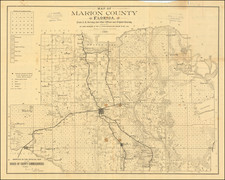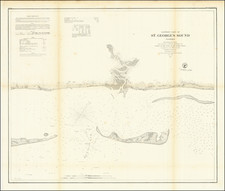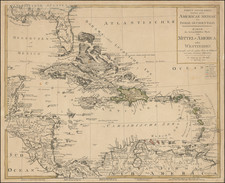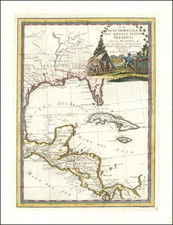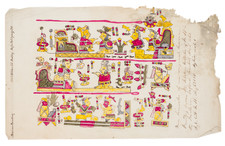Ceremonies Performed by Natives After Capturing Enemies
Original antique engraving of Florida Indians by Theodore de Bry.
This view shows the legs, arms, and scalps of the captured enemies tied to poles in the background. A sorcerer, holding a small effigy, mutters many imprecations, hexing the enemy. Three men with instruments— one beating a stone with a club, the other two with gourds filled with seed— play along to the incantations. Holata Outina, a Timucuan chieftain, speaks with French allies
A sorcerer or shaman, referred to as "Magus" in the text, holds a small figure in his hand and mutters a thousand curses or imprecations in a customary manner, condemning their enemies. Opposite him, at the far end of the area, sit three men with bent knees. One of these men holds a stick in both hands and strikes a flat stone, responding to each word of the shaman. The other two sitting by his side hold a fruit resembling a gourd or pumpkin. They remove its flesh and seeds and fill it with stones or grains. Piercing it with a stick, they shake it, making it rattle like a bell, while singing in their native manner after the shaman's murmurs.
This ceremony is performed whenever they capture enemies, marking it as a special day of celebration. The text translates as follows:
Having returned from war, they have a specific place where they usually gather. To this place, they bring the legs, arms, and scalp skin taken from their enemies, and with formal ceremony, they affix these onto long poles driven into the ground. Then, men and women sit in a circle around these body parts. A sorcerer, holding a small image in his hand, mutters a thousand curses in the customary manner, condemning their enemies. Opposite him, at the far end of the area, sit three men with bent knees. One of these men holds a club in both hands and strikes a flat stone, responding to each word of the sorcerer. The other two on either side hold the fruit of a certain plant, resembling a gourd or pumpkin, which they have dried and opened at both ends, removed the pulp and seeds, and filled with stones or grains. Piercing it with a stick, they shake it, making a sound like bells, singing in their native manner after the sorcerer's murmurs. They usually celebrate these festive days whenever they have captured some enemies.
The engravings published by Theodor de Bry in his Grand Voyages (1591), based upon watercolor illustrations made by Jacques Le Moyne de Morgues, are the earliest known European depictions of Native Americans in what is now known as the United States. Le Moyne, a member of the short-lived French colony known as Fort Caroline founded by Huguenot explorer Rene Goulaine de Laudonniere (ca. 1529-1574), based the watercolors on his experiences in Florida in the 1560s. De Bry later published Le Moyne's work, along with other illustrations of the New World, as part of an effort to encourage European colonization in the Americas. Jacques le Moyne de Morgues, an illustrator and explorer, sailed with René de Laudonnière on the 1564 Huguenot expedition to Florida. Laudonnière set up Fort Caroline on the St. John's River in 1564, but the settlement was destroyed by the Spanish army under Pedro Menendez de Aviles.
De Bry's Engravings of the Florida Indians
For his Grands Voyages, De Bry engraved 42 plates based Le Moyne's original sketches made during the French Huguenot voyage to the Florida Peninsula. De Bry's renderings of Florida and its inhabitants are today the earliest known printed European images of Native Americans in present-day Florida, known as the Timucua Indians.
The images attempt to convey a number of messages about the land and its peoples. For example, some of the plates have been suggested to represent the ability of the Timucua to obey authority and that they are less sophisticated than the Europeans. This was argued to make them ideal candidates for French Huegonot colonization, to be used in conflicts against Catholic Spain.
The accuracy of De Bry's depictions have sometimes been called into question. Some of the engravings do not quite match what became known about the Timucua by later French explorers, and some engravings possess out-of-place features, such as the appearance of a Pacific nautilus rather than a Florida whelk shell. However, it is believed that the core of the imagery is correct. For example, the depiction of Timucuan body art, otherwise unknown to Europeans at the time, suggest that De Bry's depictions were grounded in reality.
Theodor de Bry (1528-1598) was a prominent Flemish engraver and publisher best known for his engravings of the New World. Born in Liege, de Bry hailed from the portion of Flanders then controlled by Spain. The de Brys were a family of jewelers and engravers, and young Theodor was trained in those artisanal trades.
As a Lutheran, however, his life and livelihood were threatened when the Spanish Inquisition cracked down on non-Catholics. De Bry was banished and his goods seized in 1570. He fled to Strasbourg, where he studied under the Huguenot engraver Etienne Delaune. He also traveled to Antwerp, London, and Frankfurt, where he settled with his family.
In 1590, de Bry began to publish his Les Grands Voyages, which would eventually stretch to thirty volumes released by de Bry and his two sons. The volumes contained not only important engraved images of the New World, the first many had seen of the geographic novelties, but also several important maps. He also published a collection focused on India Orientalis. Les Grands Voyages was published in German, Latin, French, and English, extending de Bry’s fame and his view of the New World.









